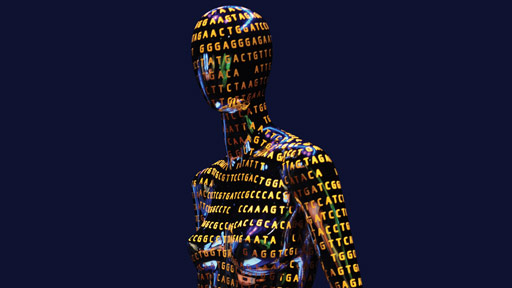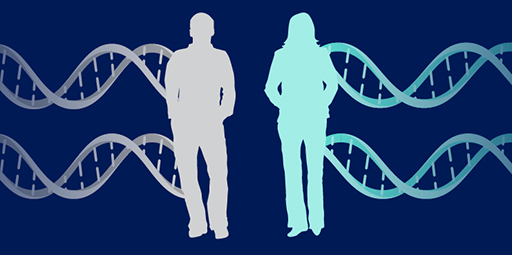Genome exhibition to depart Smithsonian for multi-city tour
With eye-catching models, interactive displays and engaging elements, the Genome: Unlocking Life's Code exhibition is going on tour after having completed a 14-month engagement at the Smithsonian's National Museum of Natural History (NMNH) in Washington.
A High Impact Exhibition
On Sept. 1, 2014, the contemporary, high-impact exhibition-a collaboration between the museum and the National Human Genome Research Institute (NHGRI), part of the National Institutes of Health- will start engagements at museums and science centers throughout North America.
"I am gratified by the effectiveness of our ongoing collaboration with colleagues at the Smithsonian Institution on the exhibition, and by the conversations that I have had with exhibition visitors about the significance and promise of genomics," said NHGRI Director Eric D. Green, M.D., Ph.D. "Over the past year, I have enjoyed speaking with children and adults from far and wide at the exhibition, and during the educational workshops, public lectures and celebrations in Washington. Now it is time for the exhibition to travel so that others in North America can see it."
Genome: Unlocking Life's Code opened a decade after the completion of the Human Genome Project and 60 years after the discovery of the double-helical structure of DNA by Drs. James Watson and Francis Crick. Dr. Watson toured the exhibition in July, one of its estimated 3 million visitors since the opening.
Museum designers and education programming experts took almost two years to conceptualize and build the 4,400 square-foot exhibition. By illustrating and explaining genomics, the exhibition offers visitors a new perspective from which to view oneself - as an individual, a member of a family, a representative of a species, and part of the diversity of life on Earth.
The initial stops for the traveling exhibition are:
- Reuben H. Fleet Science Center, San Diego, Sept. 24, 2014 - Jan. 4, 2015
- The Tech Museum of Innovation, San Jose, California, Jan. 22 - April 27, 2015
- St. Louis Science Center, May 15 - Sept. 10, 2015
- Oregon Museum of Science and Industry, Portland, Oct. 2, 2015 - Jan. 3, 2016
- Discovery World, Milwaukee, Winter 2016
- Exploration Place, Wichita, Kansas, Sept. 30, 2016 - Jan. 1, 2017
- Peoria (Illinois) Riverfront Museum, Jan. 28 - May 29, 2017
- Science North, Sudbury, Ontario, Sept. 30, 2017 - Jan. 1, 2018
"Thanks to this unique partnership between the Smithsonian and National Institutes of Health, millions of visitors to the National Museum of Natural History have explored examples of how genomics is enabling new discoveries in the fields of medicine, natural sciences and evolutionary biology," said Kirk Johnson, Ph.D., Sant Director of the National Museum of Natural History. "This has been a fantastic opportunity to share the excitement and significance of cutting-edge genomic science with our vast audience."
Visitors surveyed after visiting the exhibition at the National Museum of Natural History said it was "amazing," "cool," and "a fun place to come." A steady stream of middle school and high school students-the exhibition's prime audience-has filed through the exhibition. Twice as many 12- to 18-year-olds visited the exhibition than what is typical in the other galleries of the NMNH.
Education and scientific experts at NMNH and NHGRI developed the interactive content and online companion programming for the exhibition. The interactive, futuristic environment communicates the revolutionary nature of genomics and is aimed at sparking thoughtful discussion-among teens and their parents, and teens and their teachers. A display known as the Trait Tree has been the most popular stop, enabling visitors to discover unique traits of their own. It is part of the Genome Zone, an area of the exhibition that offers hands-on learning experiences.
"The Genome: Unlocking Life's Code exhibition has enriched our engagement with the public," said Vence L. Bonham, Jr., chief of the Education and Community Involvement Branch in NHGRI's Division of Policy, Communications and Education. "We plan to continue to conduct programs to enhance the public's knowledge of genomics in collaboration with museums and science centers as the exhibition rolls into towns across the country."
The exhibition is accompanied by a website, unlockinglifescode.org, with educational resources that can be used to teach students about DNA, and educational videos for learners of all ages. Videos of many of the public educational programs, including lectures, symposia, discussion panels and informal gatherings, held in conjunction with the exhibition, have been posted on NHGRI's website.
About Genome: Unlocking Life's Code
Genome: Unlocking Life's Code is organized around three major themes, each exploring numerous topics through the latest imagery on genomics, hands-on and media interactives, videos and other engaging content:
- The Genome Within Us: Upon arrival, museum-goers are oriented at the center of the exhibition where they explore how the genome is a part of their own bodies. Visitors will discover what a genome is, where it is located in the human body (in the cell nucleus), and how it works to regulate life. Visitors will see a three-dimensional model of a human genome and watch interviews with Human Genome Project researchers. Visitors can also participate in a social media interactive where they can explore the ethical, legal and social implications of advancing DNA sequencing technologies, submit their responses on an interactive station and find out how their views compare with those of other visitors. An electronic news ticker display provides an ongoing stream of recent developments in genomics.
- Your Genome, Your Health: Guests can explore the many ways in which genome sequencing benefits patients through improved health care. They can learn about genes, genomic solutions to mysterious medical diseases, and, through a futuristic DNA interactive, search for the right medicine for a given disease. An interactive puzzle allows visitors to learn how genetic, environmental and random factors influence risk for a particular disease.
- Connections: Natural World and Genomic Journey: Visitors can learn about the ways that genomes reflect the connection of all life on the planet, human ancestry and evolution - and even human society. They can learn more about how the Smithsonian is using new genomic technologies to preserve genetic diversity and study changes in our environment through the Global Genome Initiative (GGI) and its growing biorepository.
- The Genome Zone: Visitors are presented with a lively room, full of conversations, educational activities and hands-on learning experiences that all personalize a genome. They can discover what unique traits they have at the "Trait Tree," explore how much information their genomes can store despite their molecular scale at the "Genome in Time" and participate in a diversity of activities that all relate visitors to their own genomes in personal and tangible ways.
NHGRI is one of the 27 institutes and centers at the National Institutes of Health, which is an agency of the U.S. Department of Health and Human Services. NHGRI conducts genomics research in its own labs in Maryland, as well supports genomics research at institutions across the country. Additional information about NHGRI can be found at www.genome.gov.
About the National Institutes of Health (NIH): NIH, the nation's medical research agency, includes 27 institutes and centers and is a component of the U.S. Department of Health and Human Services. NIH is the primary federal agency conducting and supporting basic, clinical, and translational medical research, and is investigating the causes, treatments, and cures for both common and rare diseases. For more information about NIH and its programs, visit www.nih.gov.
The Smithsonian's National Museum of Natural History, located at 10th Street and Constitution Avenue N.W., Washington, D.C., is the world's most visited natural history museum and is open every day from 10 a.m. to 5:30 p.m. with extended evening hours in the summer. It also houses the world's largest collection of natural history specimens, which are managed by a research staff of more than 100 Ph.D.-level scientists. Learn more at www.mnh.si.edu or on the museum's social media platforms.
-
A High Impact Exhibition
On...
A High Impact Exhibition
On Sept. 1, 2014, the contemporary, high-impact exhibition-a collaboration between the museum and the National Human Genome Research Institute (NHGRI), part of the National Institutes of Health- will start engagements at museums and science centers throughout North America.
"I am gratified by the effectiveness of our ongoing collaboration with colleagues at the Smithsonian Institution on the exhibition, and by the conversations that I have had with exhibition visitors about the significance and promise of genomics," said NHGRI Director Eric D. Green, M.D., Ph.D. "Over the past year, I have enjoyed speaking with children and adults from far and wide at the exhibition, and during the educational workshops, public lectures and celebrations in Washington. Now it is time for the exhibition to travel so that others in North America can see it."
Genome: Unlocking Life's Code opened a decade after the completion of the Human Genome Project and 60 years after the discovery of the double-helical structure of DNA by Drs. James Watson and Francis Crick. Dr. Watson toured the exhibition in July, one of its estimated 3 million visitors since the opening.
Museum designers and education programming experts took almost two years to conceptualize and build the 4,400 square-foot exhibition. By illustrating and explaining genomics, the exhibition offers visitors a new perspective from which to view oneself - as an individual, a member of a family, a representative of a species, and part of the diversity of life on Earth.
The initial stops for the traveling exhibition are:
- Reuben H. Fleet Science Center, San Diego, Sept. 24, 2014 - Jan. 4, 2015
- The Tech Museum of Innovation, San Jose, California, Jan. 22 - April 27, 2015
- St. Louis Science Center, May 15 - Sept. 10, 2015
- Oregon Museum of Science and Industry, Portland, Oct. 2, 2015 - Jan. 3, 2016
- Discovery World, Milwaukee, Winter 2016
- Exploration Place, Wichita, Kansas, Sept. 30, 2016 - Jan. 1, 2017
- Peoria (Illinois) Riverfront Museum, Jan. 28 - May 29, 2017
- Science North, Sudbury, Ontario, Sept. 30, 2017 - Jan. 1, 2018
"Thanks to this unique partnership between the Smithsonian and National Institutes of Health, millions of visitors to the National Museum of Natural History have explored examples of how genomics is enabling new discoveries in the fields of medicine, natural sciences and evolutionary biology," said Kirk Johnson, Ph.D., Sant Director of the National Museum of Natural History. "This has been a fantastic opportunity to share the excitement and significance of cutting-edge genomic science with our vast audience."
Visitors surveyed after visiting the exhibition at the National Museum of Natural History said it was "amazing," "cool," and "a fun place to come." A steady stream of middle school and high school students-the exhibition's prime audience-has filed through the exhibition. Twice as many 12- to 18-year-olds visited the exhibition than what is typical in the other galleries of the NMNH.
Education and scientific experts at NMNH and NHGRI developed the interactive content and online companion programming for the exhibition. The interactive, futuristic environment communicates the revolutionary nature of genomics and is aimed at sparking thoughtful discussion-among teens and their parents, and teens and their teachers. A display known as the Trait Tree has been the most popular stop, enabling visitors to discover unique traits of their own. It is part of the Genome Zone, an area of the exhibition that offers hands-on learning experiences.
"The Genome: Unlocking Life's Code exhibition has enriched our engagement with the public," said Vence L. Bonham, Jr., chief of the Education and Community Involvement Branch in NHGRI's Division of Policy, Communications and Education. "We plan to continue to conduct programs to enhance the public's knowledge of genomics in collaboration with museums and science centers as the exhibition rolls into towns across the country."
The exhibition is accompanied by a website, unlockinglifescode.org, with educational resources that can be used to teach students about DNA, and educational videos for learners of all ages. Videos of many of the public educational programs, including lectures, symposia, discussion panels and informal gatherings, held in conjunction with the exhibition, have been posted on NHGRI's website.
About Genome: Unlocking Life's Code
Genome: Unlocking Life's Code is organized around three major themes, each exploring numerous topics through the latest imagery on genomics, hands-on and media interactives, videos and other engaging content:- The Genome Within Us: Upon arrival, museum-goers are oriented at the center of the exhibition where they explore how the genome is a part of their own bodies. Visitors will discover what a genome is, where it is located in the human body (in the cell nucleus), and how it works to regulate life. Visitors will see a three-dimensional model of a human genome and watch interviews with Human Genome Project researchers. Visitors can also participate in a social media interactive where they can explore the ethical, legal and social implications of advancing DNA sequencing technologies, submit their responses on an interactive station and find out how their views compare with those of other visitors. An electronic news ticker display provides an ongoing stream of recent developments in genomics.
- Your Genome, Your Health: Guests can explore the many ways in which genome sequencing benefits patients through improved health care. They can learn about genes, genomic solutions to mysterious medical diseases, and, through a futuristic DNA interactive, search for the right medicine for a given disease. An interactive puzzle allows visitors to learn how genetic, environmental and random factors influence risk for a particular disease.
- Connections: Natural World and Genomic Journey: Visitors can learn about the ways that genomes reflect the connection of all life on the planet, human ancestry and evolution - and even human society. They can learn more about how the Smithsonian is using new genomic technologies to preserve genetic diversity and study changes in our environment through the Global Genome Initiative (GGI) and its growing biorepository.
- The Genome Zone: Visitors are presented with a lively room, full of conversations, educational activities and hands-on learning experiences that all personalize a genome. They can discover what unique traits they have at the "Trait Tree," explore how much information their genomes can store despite their molecular scale at the "Genome in Time" and participate in a diversity of activities that all relate visitors to their own genomes in personal and tangible ways.
NHGRI is one of the 27 institutes and centers at the National Institutes of Health, which is an agency of the U.S. Department of Health and Human Services. NHGRI conducts genomics research in its own labs in Maryland, as well supports genomics research at institutions across the country. Additional information about NHGRI can be found at www.genome.gov.
About the National Institutes of Health (NIH): NIH, the nation's medical research agency, includes 27 institutes and centers and is a component of the U.S. Department of Health and Human Services. NIH is the primary federal agency conducting and supporting basic, clinical, and translational medical research, and is investigating the causes, treatments, and cures for both common and rare diseases. For more information about NIH and its programs, visit www.nih.gov.
The Smithsonian's National Museum of Natural History, located at 10th Street and Constitution Avenue N.W., Washington, D.C., is the world's most visited natural history museum and is open every day from 10 a.m. to 5:30 p.m. with extended evening hours in the summer. It also houses the world's largest collection of natural history specimens, which are managed by a research staff of more than 100 Ph.D.-level scientists. Learn more at www.mnh.si.edu or on the museum's social media platforms.
Related Content
Last updated: September 9, 2016



